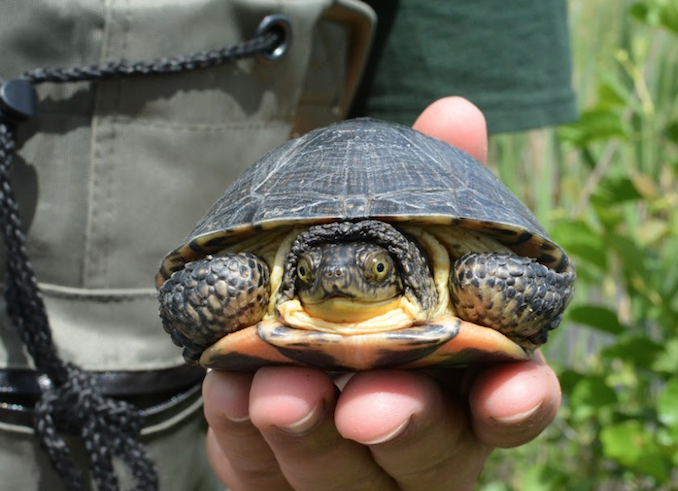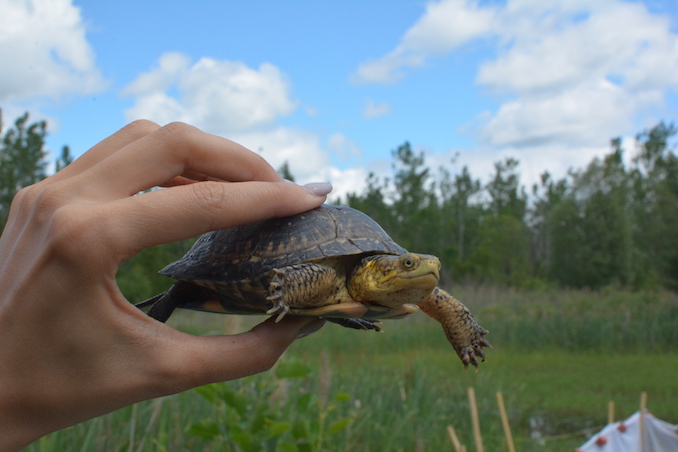The wetlands at Rouge National Urban Park just became the home for 49 baby Blanding’s turtles. The babies are getting a ‘head start’ in the soon to be completed urban park that will be Canada’s first national urban park that will span more than 79 km2 making it one of the world’s largest protected areas in an urban setting.

The Blanding’s turtle is recognizable by its bright yellow throat and jaw. The dark head and legs often have yellow speckles. The shell (carapace) is smooth and is more oblong in shape. The underside (plastron) is yellow with dark blotches. They have a long life span of up to 80 years but until recent efforts by the Toronto Zoo’s head-starting program, the species was facing imminent local extinction. While they are listed on the endangered species list by the International Union for Conservation of Nature and a provincially and nationally threatened species, efforts are now being made to help the declining population. This is the fourth year of the reintroduction and recovery program which also includes research, habitat creation, outreach and education. There are plans to release about 50 Blanding’s turtles back into the wild each spring under this program.
These turtles were rescued as eggs from at-risk nests in a stable source population in southern Ontario and have been raised in a controlled environment at the Toronto Zoo for two years. As newborns, Blanding’s turtles are the size of a loonie. They’re soft making them an easy snack for predators. They’ve been cared for past their most vulnerable stages and when their shells are harder and less appealing to common urban creatures like raccoons, skunks, and foxes.
University of Toronto (Scarborough) has joined the project assisting with monitoring of the turtles. Parks Canada, Toronto and Region Conservation Authority, and the TorontoZoo are also participating in long-term habitat improvement projects that will provide a better chance of survival and sustainability in the Rouge Valley area.
Of the 8 native turtle species in Ontario, 7 are now classified as ‘Species at Risk.’ Turtles have a long life span and are known to be highly mobile being able to travel long distances to find food or a mate. However, reproduction happens in their later years making the turtle population highly sensitive to natural and human threats. Protecting this species and their habitat helps benefit other native turtles, as well as birds, fish and other creatures that use the same wetland homes.
You can learn more about the various turtles species in this guide created by the Toronto Zoo.

We’ve been hearing news lately about turtle sightings in the GTA so what should you do when you spot one? Here’s what you need to know…
- If you see a turtle in the wild or even on a street, and it looks like it’s just travelling and not injured then just leave it alone if it’s not in harms way.
- If you assess the situation and feel it’s safer to move it then keep the turtle low to the ground just in case wiggles out of your hands you don’t want it to fall and get injured.
- If it’s a small turtle you can pick it up by holding carefully to the side of the shell behind the front legs. Use gloves if you have handy.
- Larger turtles may be more aggressive you won’t want to pick it up as they may bite in defense. Instead, help by gently nudge it along with a large stick (not poking at it) and in the direction the turtle is facing. Don’t try and make it go another direction, the turtle will most likely go back to it’s route anyway.
- Don’t attempt to relocate a turtle as they know their way back home. If you try and relocate them you could disorient them.
- Never pick up a turtle by it’s tail!
- Never release a turtle that was purchased from a pet store into the wild. Sometimes they carry diseases and they’re are not likely to survive.
How to help and handle an injured turtle: (source: Ontario Turtle Conservation Centre)
- Carefully place the injured animal in a well-ventilated plastic container with a secure lid (turtles can climb!).
- Most turtles can be picked up carefully with two hands. When handling snapping turtles keep a safe distance from their head as they will snap at you if they feel threatened. You may want to use a shovel or board to lift the turtle.
- Note the location (road, major intersections, and mileage) where the turtle was found to ensure it can be released according to provincial regulations.
- Do not transport turtles in water. Do not offer the turtle anything to eat.
- Wash your hands after handling the animal.
- If you have to keep a turtle overnight, place it in a well-ventilated container with no water and in a cool, dark place, away from pets.
- Contact the Ontario Turtle Conservation Centre (or your local wildlife rescue centre) immediately for help.




